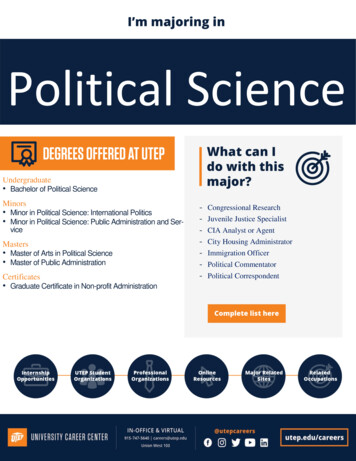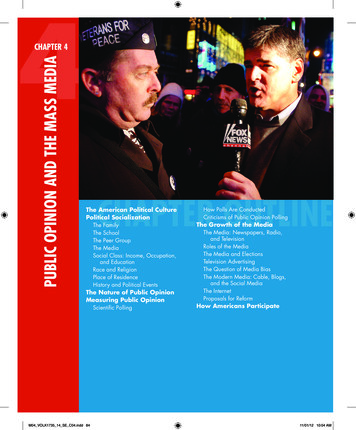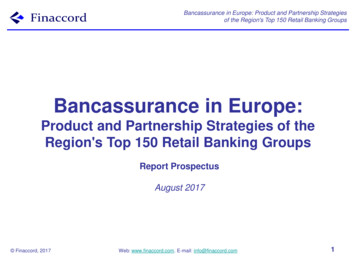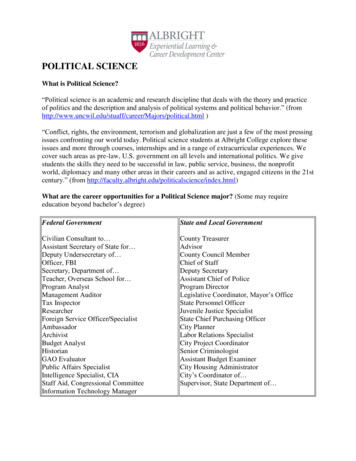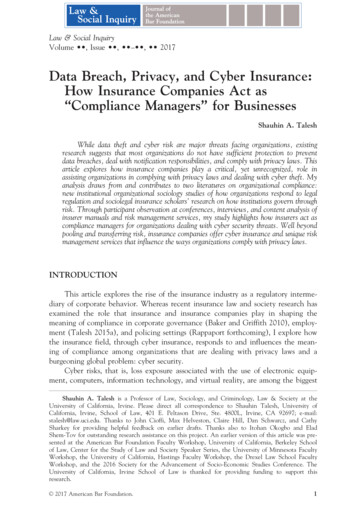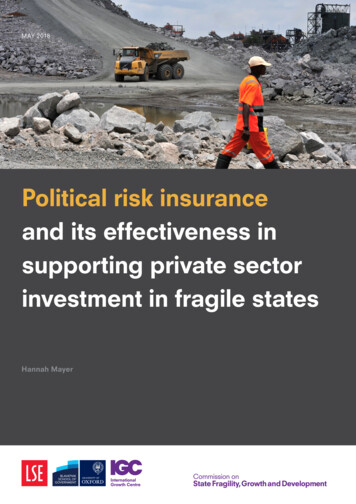
Transcription
MAY 2018Political risk insuranceand its effectiveness insupporting private sectorinvestment in fragile statesHannah Mayer
Hannah Mayer is an alumnus of the Master of Public Policy Class 2016-17 at theBlavatnik School of Government, University of Oxford.About the commissionThe LSE-Oxford Commission on State Fragility, Growth and Development waslaunched in March 2017 to guide policy to address state fragility.The commission, established under the auspices of the International GrowthCentre, is sponsored by LSE and University of Oxford’s Blavatnik School ofGovernment. It is funded from the LSE KEI Fund and the British Academy’sSustainable Development Programme through the Global Challenges ResearchFund.Cover photo: Issouf Sanogo/Getty2Political risk insurance and its effectiveness in supporting private sector investment in fragile states
Contents3Executive Summary4Methodology5Background6Analysis of market for political risk al risk insurance and its effectiveness in supporting private sector investment in fragile states
ExecutiveSummaryFragile states are unable to attract the private sector investment which is neededfor economic development in large part because of high levels of political riskfaced by investors. This paper investigates the role political risk insurance (PRI)plays in mitigating political risk and encouraging investment in fragile states.It analyses the private and public market for PRI in fragile states and makesrecommendations for how it could be strengthened.The paper finds that PRI plays a limited and yet important role in enablingviable investments to proceed in fragile states. Currently, provision and purchaseof PRI in fragile states is low because it is too costly to purchase on the privatemarket, investors are unfamiliar with it as a tool, or they do not view it as the rightinstrument to mitigate political risk. Multilateral institutions play a critical role inproviding PRI in fragile states where the private market is not able to.Several recommendations are made for increasing provision of PRI infragile states, including: increased role of multilateral institutions, developmentfinance institutions and export credit agencies; greater collaboration betweenpublic and private providers of PRI through co-insurance and re-insurance; andextending the PRI market to provide insurance to local investors. These policiesshould be pursued in parallel to host country reform to create a more conduciveenvironment for doing business.4Political risk insurance and its effectiveness in supporting private sector investment in fragile states
MethodologyThe report’s findings are based on a review of available literature on PRI andfragile states, and on interviews with the organisations listed below. The viewsrepresented in this paper are the author’s alone and not of those interviewed. Africa Trade Insurance (ATI) Berne Union GuarantCo Liberty Speciality Markets Lion’s Head Marsh Insurance Broker Milken Institute Organisation for Economic Cooperation and Development (OECD) Private Infrastructure Development Group (PIDG) Sovereign Risk Insurance UK Department for International Development (DFID) UK Export Finance US Overseas Private Investment Corporation (OPIC) World Bank International Development Association (IDA) World Bank International Finance Corporation (IFC) World Bank Multilateral Investment Guarantee Agency (MIGA)The paper is structured as follows: the Background section outlines thechallenge of securing investment in fragile states due to political risk; theAnalysis section analyses the market for PRI in fragile states, and identifiessupply and demand reasons for why provision and take-up of PRI in fragilestates is low. Due to the limitations of the private market, it discusses the role ofthe public market in extending PRI to fragile states. The Options section makesrecommendations for how provision of PRI in fragile states can be strengthenedto support increased private sector activity. The findings of this report arerelevant to policymakers, investors, and insurers in the PRI industry.5Political risk insurance and its effectiveness in supporting private sector investment in fragile states
BackgroundFragile and conflict-affected statesDefining the term ‘fragile state’ is challenging. International organisations usedifferent methodologies to categorise states as fragile and their criteria forinclusion on lists of fragile states often varies.1 For the purpose of this paper, Ifollow the approach of the LSE-Oxford Commission on State Fragility, Growthand Development which has identified five broad dimensions of fragility: statelegitimacy, state effectiveness, private sector development, security and conflict,and resilience. I will proceed with the assumption that a fragile state has difficultyon at least one of these five dimensions. As discussed below, the extent offragility in a state is an important factor in determining the availability of politicalrisk insurance.Issue: Challenge of securing private investment in fragilestatesBy 2050, almost half of the world’s population living in poverty will be found infragile and conflict-affected states (OECD 2013). Critical to the developmentof these states and their path out of fragility is a strong private sector whichcan create economic growth through investment in key industries such asinfrastructure, manufacturing, and extractives. Yet fragile states struggle toattract the private sector investment they need in large part because of highlevels of political risk which deter foreign investors from investing in theseenvironments.Currently, foreign direct investment (FDI) makes up a small proportion offlows to fragile states. Official development assistance (ODA) is the largestsource of external financing to fragile states, followed by remittances, and thenFDI (OECD 2013). While the World Bank estimated that between 2005–2010fragile states absorbed 5-8% of FDI into developing countries, which wascommensurate with their economic weight of 6-7% of developing countries’GDP, this finance was concentrated in a handful of resource-rich economies1Widely utilised lists include the World Bank Harmonized list of Fragile Situations and the Fundfor Peace Fragile States Index. According to the World Bank there are 35 fragile states in 2017 outof more than 140 developing countries, including: Afghanistan, Burundi, Cameroon, CAR, Chad,Comoros, DRC, Eritrea, Guinea-Bissau, Haiti, Kiribati, Liberia, Myanmar, Niger, Nigeria, Sierra Leone,Solomon Islands, Somalia, Sudan, South Sudan, Timor-Leste, Togo, Yemen, Zimbabwe.6Political risk insurance and its effectiveness in supporting private sector investment in fragile states
(MIGA 2011). In 2012, the majority of FDI to fragile states went to just sixcountries—Nigeria, Iraq, Democratic Republic of the Congo, Egypt, Congo,and Sudan—for use primarily in the extractives sector (OECD 2015). Fragileeconomies suffer from an absence of private debt flows, as they have limitedaccess to private debt markets. Portfolio equity flows, an alternative source offoreign capital, are also extremely limited because of underdeveloped financialsectors and equity markets (MIGA 2010). Despite average rates of return oninvestment into fragile states being high, fragile states can’t attract sufficientprivate sector investment which is needed for development and progresstowards the Sustainable Development Goals. 2Political risk insuranceA critical reason for lack of private investment in fragile states is high levelsof political risk. Investors cite political risk as the single most importantconstraint for investing in developing countries over the medium-term, followedby macroeconomic instability (MIGA 2011). Political risk, as distinct fromcommercial risk, is the risk of disruption to company operations by politicalforces or events. It covers a range of issues such as political violence and war,government expropriation of assets, breach of contract, wrongful calling of creditletters, arbitration award defaults, foreign currency inconvertibility, and inabilityto repatriate funds (Ginsberg 2013). Of these political risks, the World BankMultilateral Investment Guarantee Agency (MIGA) and Economist IntelligenceUnit (EIU) 2013 Political Risk Survey found that foreign companies listed adverseregulatory changes and breach of contract as the greatest impediment to doingbusiness in developing economies (MIGA 2013). An example of a regulatorychange could include the Tanzanian government’s decision in March 2017 to banforeign exports of gold and copper ore.3The key tool for mitigating political risk is the purchase of political riskinsurance (PRI). PRI is available privately through private insurance companies, orpublically through multilateral institutions such as MIGA and bilateral institutionssuch as government export credit agencies. PRI provides protection against therisk that actions of foreign governments or political groups will negatively impactwhat were otherwise sound commercial investments. It is designed to meetthe needs of equity investors and banks making loans to commercial entitiesin foreign markets and is frequently used in the extractives, manufacturing,construction, retail, and services sectors. PRI typically provides coverage forthe various kinds of political risks, like nationalisation and expropriation ofassets, restriction on remittances, political violence and war damages, currencyinconvertibility, and breach of contract.2MIGA calculated that between 2006 -11 average rate of return on FDI into fragile and conflictaffected states was 14.5% compared to 9.7% for all low-income countries (Barbour 1e7-96f8-3700c5664d30Political risk insurance and its effectiveness in supporting private sector investment in fragile states
Analysis of themarket for politicalrisk insurance infragile statesGlobal demand for PRI has continued to grow since the financial crisis. In 2016,Berne Union members issued 112 billion in investment insurance, which was a20% increase over the previous year (Berne Union 2016).4 Of this new growth,17% was in South East Asia, 15% in former Soviet Union states, 12% in SubSaharan Africa, and 12% in Latin America. However, this global trend does notcorrelate with fragile states, where both availability and purchase of PRI remainslow. Currently PRI covers only 10% of emerging market investment. When MIGAsurveyed 60 executives of multinational companies (MNCs) investing in fragilestates, only 13% reported seeking PRI and fewer still ended up contractingit (MIGA 2011). MNCs are not extensively using PRI in their political riskmanagement strategies despite identifying political risk as the key challenge infragile states.The investors who purchase PRI tend to be large institutional investors basedin the Global North, with projects in multiple countries. While investors from theGlobal South are equally affected by political risk, they tend to purchase PRIless frequently and carry less weight in negotiating the terms of a PRI agreement(MIGA 2011; Klasen 2016). Similarly, debt-holders, such as banks, purchase PRIdue to regulatory requirements, whereas equity investors and those investing inprimary sectors (e.g., agriculture and forestry) often have a higher risk toleranceand purchase PRI less frequently. Banks seek insurance against governmentsfailing to honour contracts for political reasons, whereas smaller and more localinvestors are less accustomed to purchasing PRI.The following analysis explains why the market for PRI is failing to providesufficient PRI for investors in fragile states and why PRI remains a niche product4Berne Union is a trade association representing global export credit and investment insurers. Itprovides the most authoritative figures on PRI across the industry. Although investment insuranceincludes sovereign non-payment statistics and cross-border trade as well as PRI, these statistics arethe most comprehensive on PRI issuance.8Political risk insurance and its effectiveness in supporting private sector investment in fragile states
in these environments.Supply side: Limitations of private PRI markets in fragile statesOne of the primary reasons for lack of purchase of PRI in fragile states is that it’seither not available or prohibitively expensive on the private insurance market.The private market for PRI is dominated by key providers such as Lloyd’sof London and its 32 syndicates, Sovereign, Zurich, AIG, and Chubb. Theseproviders are primarily based in three insurance centres – London, Bermuda,and New York. The range of political risks covered by private insurers is broadlythe same as those covered by public insurers: currency inconvertibility andtransfer restrictions; confiscation, expropriation, and nationalisation; politicalviolence; and default on obligations such as loans and contracts. PRI capacityin the private market increased by just over 7% to 1.7 trillion between July 2012and July 2013 (MIGA 2013). Yet, while the private market for PRI is growing, itsprovision in fragile states remains restricted. Insurance is heavily concentratedin a handful of resource-rich countries, mirroring FDI flows, which absorb over60% of PRI coverage in fragile economies and has been underwritten by a smallnumber of insurers (MIGA 2011).There are several reasons why private provision of PRI in fragile states is bothminimal and expensive. Risk in fragile states is by definition higher than in non-fragile states, andtherefore more expensive to price.5 Risk is logarithmic and rate is linear -- oncea risk reaches a certain level, insurers can’t charge a high enough premium.6The risk, for example, that a sovereign fragile state government will defaulton its obligations is high, and it is hard to design an incentive arrangement tostop this threat of default. Private insurers take a more cautious and conservative view of the market infragile states than public providers due to a lack of data on defaults. It is harder to price risk in fragile states as there is an absence of a credibledata pattern to follow. Political events are volatile, losses are unpredictableand it is difficult to build statistical models for actuarial estimates of futurelosses. There is a high likelihood of a single catastrophic event with crosscountry impact that could wipe out years of profits. Insurers therefore need tohold large amounts of equity in anticipation of losses (Hamdani 2005). Pricing risk in fragile states requires insurers to have a detailed knowledge ofthe context of a country, and to carry out significant information gatheringand due diligence to write non-standardised and bespoke contracts. Localcountry knowledge is costly to acquire and pushes up costs.Private provision of PRI in fragile states is therefore limited and often pricedexorbitantly for investors.5Although fragile states do not appear to have generated significantly more claims than non-fragilecountries (see MIGA 2011:64).69See Stiglitz & Weiss (1981) on credit rationing.Political risk insurance and its effectiveness in supporting private sector investment in fragile states
Demand side: Lack of investor familiarity and purchase of PRIThe second set of reasons which explains the lack of purchase of PRI in fragilestates is that investors are either not familiar with PRI as a tool or they don’t viewit as the right instrument to mitigate political risk.The interviews conducted for this research indicate that there are viablecommercial investments that currently do not proceed because some investorsare unfamiliar with PRI as a tool to support investment. Even when investors arefamiliar with PRI, they may still not think it is the right tool to mitigate political riskin fragile states for the following reasons: Concern that a claim would not be paid by the insurance company due tothe difficulty of drafting contracts in fragile states that foresee all possiblecontingencies. For example, investors and insurers may disagree over whatconstitutes lack of physical access to a construction site. For this reason,many investors now look to buy comprehensive insurance which is moreextensive than named peril policies and covers commercial and political risk. Many investors who do anticipate political risk decide to forego PRI becausethey perceive the risk to be manageable, potential losses to be limited, or thatinvestment can be easily relocated. If there is a breach of contract, investors often view contract renegotiationand concession agreements with stabilisation clauses as more effective thanPRI. Some investors prefer non-contractual tools to mitigate political risk such asjoint ventures with local companies, engagement with host government andin-house political risk analysis (MIGA 2011).These reasons point to the fact that PRI is not a panacea to attract privateinvestment into fragile states.Moreover, for an investment to proceed, there are several preconditions thatneed to be met to make an investment commercially viable, such as access tofinance, adequate supply of electricity, reasonable assurance on property rights,and banking facilities. Investors must be reassured on these issues before theavailability of PRI becomes a relevant factor in determining whether to pursuean investment opportunity. PRI is a secondary tool that acts as a confidencebooster to avoid catastrophic loss.Public provision of PRIDespite its limited scope, PRI does have a role to play in mitigating political riskand is one instrument that can ease constraints on private investment and enablean investment to proceed that otherwise would not have been viable.Given the limitation of private provision of PRI, public providers, particularlymultilateral institutions, have a key role to play in expanding the availability of PRIin fragile states. Public provision of PRI offers the following benefits: Multilateral providers can assume more risk than private providers becausethey are not driven by purely commercial concerns and can insure projectsthat would be deemed too risky for private insurers.10Political risk insurance and its effectiveness in supporting private sector investment in fragile states
Multilateral institutions can use their standing in the international community,and the support they have from shareholder governments to resolve disputesbetween the investor and the host government. Multilaterals have a deterrenteffect, influencing host governments over the lifetime of a project to preventclaims from manifesting.7 Public insurers offer longer tenure of coverage (e.g. 20 years) whereas privateinsurers tend to only offer up to five years. Private insurers perceive the riskof long tenure to be high because they are concerned with issues such aselection cycle changes and inability to recalibrate risks (Iftinchi 2016). Public insurers offer lower and more constant premium levels, whereas privateinsurance premium levels can fluctuate widely based on the nature of theproject.The key multilateral providers of PRI include MIGA, African Trade Insurance,Islamic Corporation for Insurance of Investment and Export Credit, the Inter-ArabInvestment Guarantee Corporation, the Asian and African Development Bank. 8MIGAMIGA is the World Bank’s guarantee arm and the largest multilateral provider ofPRI. In addition to traditional PRI, in recent years MIGA has expanded its creditenhancement products to cover non-honouring of sovereign financial obligationsand non-honouring of financial obligations of state-owned enterprises (MIGA2017). MIGA emphasises its strong ability to resolve potential investmentdisputes, due to its status as a member of the World Bank Group. Its leverageover governments means that MIGA has a low claims ratio, which enables it tooffer products at more affordable prices.In recent years MIGA has worked to scale up its investment in fragile states(World Bank 2014). Its exposure in fragile and conflict-affected states was 10% infinancial years 2007-2012. This support was highly concentrated in infrastructure,agribusiness, manufacturing, and services sectors, rather than financial sectors(World Bank 2014). Over the financial years 2015-2017 strategy period, MIGA’ssupport of projects in fragile states totalled 0.7 billion out of 9.7 billion. In thefirst half of financial year 2017, 17% of the 2.5 billion of guarantees issued byMIGA supported investments in fragile situations (MIGA 2017).As part of the IDA18 replenishment, the World Bank created a 2.5 billionPrivate Sector Window (PSW) to catalyse private sector investment in IDA-onlycountries, with a focus on fragile states. Half of these funds will be used in aMIGA Guarantee Facility (MGF) to provide shared first-loss on guarantees andrisk participation akin to reinsurance. The MGF will aim to provide PRI in fragilestates where commercial coverage is lacking and builds on a previous donorfunded MIGA facility called the Conflict-Affected and Fragile Economies Facility(CAFEF).The disadvantage of large multilaterals such as MIGA is that they can be7Although this will have limited effect if a fragile state government doesn’t respond to multilateralpressure or care about international reputation.811The development banks offer partial risk guarantee programmes.Political risk insurance and its effectiveness in supporting private sector investment in fragile states
bureaucratic and less investor-friendly. While private insurers can rapidly drawup tailor-made contracts, MIGA guarantees must meet various development andsustainability goals. Consequently, the application process for investors can beboth lengthy and onerous.African Trade Insurance AgencyAn example of a smaller and arguably more flexible multilateral institution isthe Africa Trade Insurance (ATI) Agency. Its mission is to attract investmentsand facilitate trade in Africa by removing political and credit risk. With a grossexposure of more than 2 billion, capital of 220 million and an income of 29 million, ATI offers PRI, commercial credit insurance, and non-honoring ofsovereign and sub-sovereign obligations. ATI’s current members are Benin,Burundi, Cote d’Ivoire, DRC, Ethiopia, Kenya, Madagascar, Malawi, Rwanda,Tanzania, Uganda, Zambia, and Zimbabwe, and its shareholders include theAfrican Development Bank and UK Export Finance. ATI insures an average of 1%of their member countries’ GDP per annum. ATI is able to offer flexible deals andwork in partnership with local banks in its member countries. It has expertise inthe energy sector and has, for example, supported the Africa Energy GuaranteeFacility together with the European Investment Bank.Export credit agenciesIn addition to multilateral institutions, the other type of public PRI providers areExport Credit Agencies (ECAs) which offer PRI to corporations from their homecountry. ECAs provide government-backed loans, guarantees, and insuranceto domestic corporations that are seeking to do business in developingcountries and emerging markets. Like multilateral institutions, ECAs can usetheir diplomatic networks to resolve disputes with host governments andpromote responsible business conduct . Unlike multilateral institutions, ECAsare commercially-focused as their primary aim is to promote their countries’exports rather than conduct development work. Each country’s ECA is different.Some, for example, act as insurers of last resort, while others actively markettheir support. Most ECAs offer limited PRI in fragile states because of highcountry risk ratings and foreign policy considerations. The UK Export Financeagency (UKEF) for example is not currently active in most fragile states. UKEFhas to price to risk and underwrite insurable risks, meaning they cannot take onsubstantially more risk than the private sector.Currently multilateral institutions are best placed to provide PRI in fragilestates because they don’t have to be purely commercially driven and canassume more risk than ECAs and private insurers. However, even the ability ofmultilateral agencies to provide PRI diminishes in extremely fragile states suchas Yemen, Central African Republic, and South Sudan. In the most fragile states,risk is too high for multilaterals and the ability of such institutions to leveragetheir international standing in resolving investor-state disputes is diminished. Iffragile state governments are not concerned with their international reputation,they will be less likely to respond to pressure from multilaterals to resolveinvestor disputes. In less fragile states, the capacity of multilaterals to provide12Political risk insurance and its effectiveness in supporting private sector investment in fragile states
PRI might still be limited if countries have over-indebted themselves (e.g., in thecase of Zambia) and therefore the insurance market is saturated. The fragilestates where PRI tends to be most widely used and most effective is wherethere is a functioning government of some kind, and PRI can provide protectionagainst nationalist actions of that government. In fragile states where there is noregulatory response from government, it is difficult for multilaterals to providecover.West Bank and Gaza (WB&G) case study 13Private insurers shy away from underwriting investments in WB&G becausethey are unfamiliar with the market and view the risk of Gaza conflict andIsraeli government interference as too high.Some private insurers provide political violence cover in West Bank but withshort-term tenure and without expropriation or currency transfer cover.Multilaterals such as MIGA have attempted to provide PRI in WB&G. MIGAestablished the WB&G Investment Guarantee Trust Fund to specificallyunderwrite investments in Palestine, however it struggled to attract sufficientforeign investment demand. In 2008, MIGA amended the facility to make itavailable to local investors in WB&G. This proved more successful, and MIGAwas able to support local Palestinian SMEs. This change required MIGA tohave a business developer on the ground to explain PRI to local investors.While some initiatives focused on local lending and credit guarantees havebeen successful, the availability of PRI in WB&G remains limited.The Arab Export and Credit Agency and Islamic Development Bank offersome coverage, but both are risk averse, shying away from insuring projectsin Gaza and investments against Israeli activities. OPIC offers PRI coveragebut only to US investors.Political risk insurance and its effectiveness in supporting private sector investment in fragile states
OptionsAs this paper has set out above, the PRI market is composed of private andpublic (multilateral and ECAs) providers, with multilaterals playing a key role inoffering PRI in fragile states. There remains a lack of supply and take-up of PRIin fragile states, despite the activity of multilaterals, thus hindering the ability offragile states to attract the private investment they need.The following options set out how this can be remedied. This paperrecommends that policymakers in the international community pursue options A,B, C, and host country governments pursue option E as a complementary reform.A. Increased role of multilaterals and ECAs to provide morePRI in fragile states, supported by funding from DevelopmentFinance InstitutionsThere is scope for multilateral institutions to assume more risk in fragile statesand offer an increased supply of PRI. While the IDA18 Private Sector Window(PSW) represents an important step forward in doing this, more can be done. Onthe PSW specifically MIGA should: Ensure they robustly measure the additionality of the PSW against acounterfactual to track new investment in fragile states. Ensure they create sufficient demand for use of PSW funds by locatingbusiness developers on the ground in fragile states who explain PRI toinvestors. Introduce specialised Trust Funds like the West Bank and Gaza Trust Fundwhich ensures PRI is available in some of the hardest-to-reach fragile states.ECAs should extend their coverage to fragile states by: Marketing their added value in offering longer tenure of loans than the privatemarket. Focusing on being active in markets which are recovering fromconflict. Offering cover where the private market is active but short of capacity and sorequires reinsurance. Rebranding themselves to have more of a stated development impact likethe Overseas Private Investment Corporation (OPIC) in the US whose14Political risk insurance and its effectiveness in supporting private sector investment in fragile states
investments both support US companies and exhibit host country benefit.9 UKEF should refresh their Overseas Investment Insurance to make it moreaffordable and accessible to investors.The multilaterals and ECAs will require collateral in order to assume more risk infragile states while also remaining financially sustainable. This could be providedby development finance institutions (DFIs) such as DFID and USAID. The benefit ofaid agencies using their funds to support insurance is that it leverages more impact(e.g., 1 of insurance could leverage 10 of private sector investment). Some aidagencies such as DFID, USAID, and SIDA have already supported such projects,but substantially more funding could be assigned to this.10B. Increased partnership between multilaterals/ECAs andprivate insurersWhile multilaterals and ECAs have an important role to play in extending coverageof PRI in fragile states, there is also a risk of crowding out the private market andcreating a situation where investors are overly reliant on multilaterals and DFIs forbackstopping deals.11 The role of public insurers should be to pioneer new markets,providing insurance only where the private market fails to offer it on reasonableterms.An effective way to crowd in the private market is through coinsur
The key tool for mitigating political risk is the purchase of political risk insurance (PRI). PRI is available privately through private insurance companies, or publically through multilateral institutions such as MIGA and bilateral institutions such as government export credit agencies. PRI provides protection against the

